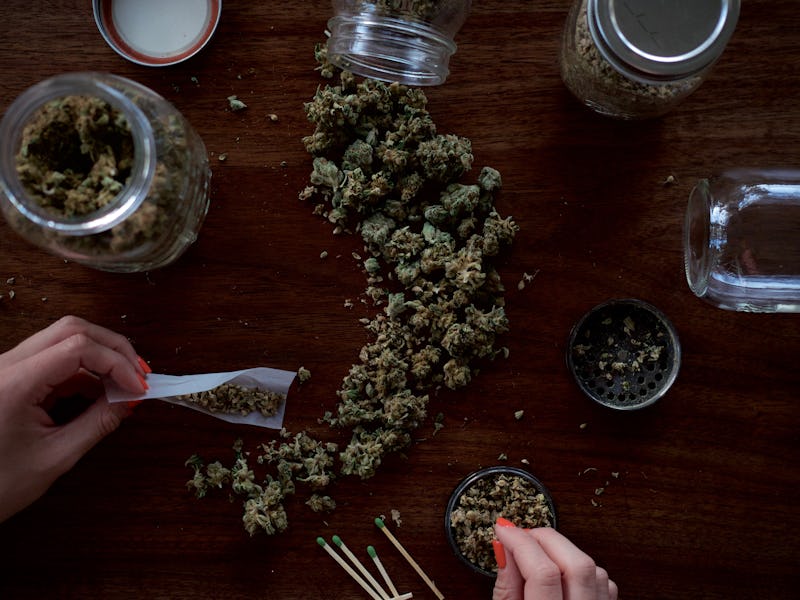Yeast Biologists Made Marijuana Compounds Without Using Any Marijuana
The cannabis plant may no longer be needed for THC and CBD.

One of the biggest hurdles to getting people on board with medical marijuana is that some people don’t like marijuana. Even as legalization becomes widespread, weed has a long way to go before it fully sheds its bad reputation. In the meantime, the findings of a Nature study published Wednesday could help make marijuana useful to people who are leery of its past. By hacking the biology of yeast, scientists found a way to make marijuana’s active ingredients without the marijuana plant.
The study, led by Jay Keasling, Ph.D., a University of California, Berkeley chemical engineering and bioengineering professor, shows that yeast can be genetically modified to produce some major cannabinoids, the chemical compounds found in marijuana.
The most well-known cannabinoids are THC, known for its ability to get people high, and CBD (cannabidiol), associated with relief from pain and anxiety. These compounds, and the dozens of other known cannabinoids in the plant, seem to play various roles in the therapeutic benefits of medical marijuana. Keasling and his colleagues show that yeast can be used to produce THCA (Δ9-tetrahydrocannabinolic acid) and CBDA (cannabidiolic acid), the chemical precursors to THC and CBD.
Yeast modified to produce cannabinoids open the door to marijuana-based drugs that don't require the plant.
This technique is nothing new: Genetically modified yeast has previously been modified to produce hops to impart beer’s flavor, synthetic egg whites, and even chemicals to flavor chocolate. Genetic modification techniques like CRISPR/Cas9 can be used to hijack the yeast’s usual processes for producing compounds by allowing scientists to insert a gene from a different organism — carrying the instructions for making a different chemical — into the genome of the yeast. As the yeast cells carry on their lives as usual, they produce the desired chemical, which the scientists can then collect.
In this case, the team gave their yeast a Cannabis-derived gene that carries instructions for producing olivetolic acid, a precursor compound to THC or CBD. They also gave them Cannabis genes that would create the enzymes that could actually turn olivetolic acid into THC and CBD. And so, together with a steady diet of the simple sugar galactose, the yeast had everything they needed to do the team’s bidding.
“Together,” the team writes, “these results lay the foundation for the large-scale production of both natural and synthetic cannabinoids, which could improve pharmacological research into these compounds.”
The point of this study was to figure out how to produce cannabinoids “independent of cannabis cultivation”; in other words, to reap the benefits of marijuana without needing the plant. There is a big upside to doing so: Cannabinoids currently used for prescription drugs (like the CBD-based anti-seizure drug Epidiolex) are derived directly from the plant, where they don’t actually exist in very high concentrations. If the same compound can be produced artificially, it’ll be much easier to scale up to make prescription drugs.
And, of course, for the weed-conservative public, it’s much easier to take a pill containing marijuana compounds than to use marijuana itself. In the same way that opium poppy-derived opioids like codeine and morphine are commonly used as drugs but it’s now taboo to get high on opium poppies themselves, the door is now open for chemicals like CBD and THC to exist and be produced, far away from the misunderstood plant from which they came from in the first place.
Abstract:
Cannabis sativa L. has been cultivated and used around the globe for its medicinal properties for millennia. Some cannabinoids, the hallmark constituents of Cannabis, and their analogues have been investigated extensively for their potential medical applications. Certain cannabinoid formulations have been approved as prescription drugs in several countries for the treatment of a range of human ailments. However, the study and medicinal use of cannabinoids has been hampered by the legal scheduling of Cannabis, the low in planta abundances of nearly all of the dozens of known cannabinoids, and their structural complexity, which limits bulk chemical synthesis. Here we report the complete biosynthesis of the major cannabinoids cannabigerolic acid, Δ9-tetrahydrocannabinolic acid, cannabidiolic acid, Δ9- tetrahydrocannabivarinic acid and cannabidivarinic acid in Saccharomyces cerevisiae, from the simple sugar galactose. To accomplish this, we engineered the native mevalonate pathway to provide a high flux of geranyl pyrophosphate and introduced a heterologous, multi-organism-derived hexanoyl-CoA biosynthetic pathway. We also introduced the Cannabis genes that encode the enzymes involved in the biosynthesis of olivetolic acid, as well as the gene for a previously undiscovered enzyme with geranylpyrophosphate:olivetolate geranyltransferase activity and the genes for corresponding cannabinoid synthases. Furthermore, we established a biosynthetic approach that harnessed the promiscuity of several pathway genes to produce cannabinoid analogues. Feeding different fatty acids to our engineered strains yielded cannabinoid analogues with modifications in the part of the molecule that is known to alter receptor binding affinity and potency. We also demonstrated that our biological system could be complemented by simple synthetic chemistry to further expand the accessible chemical space. Our work presents a platform for the production of natural and unnatural cannabinoids that will allow for more rigorous study of these compounds and could be used in the development of treatments for a variety of human health problems.